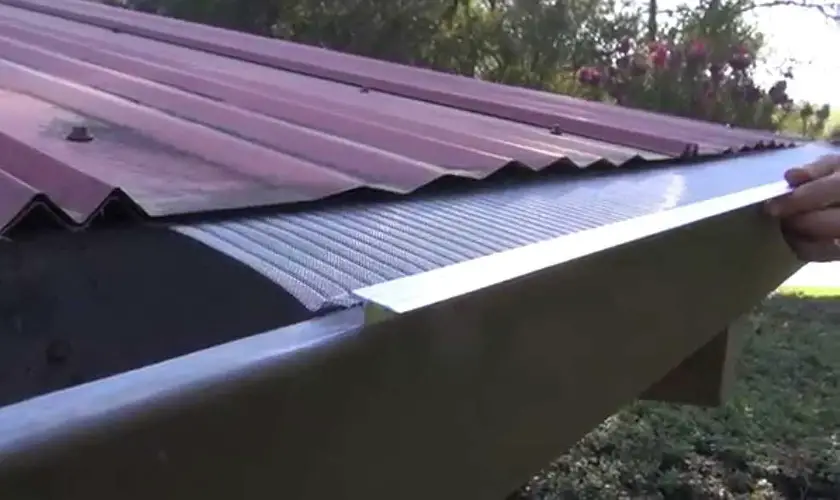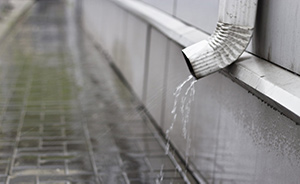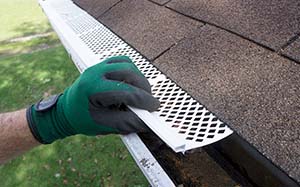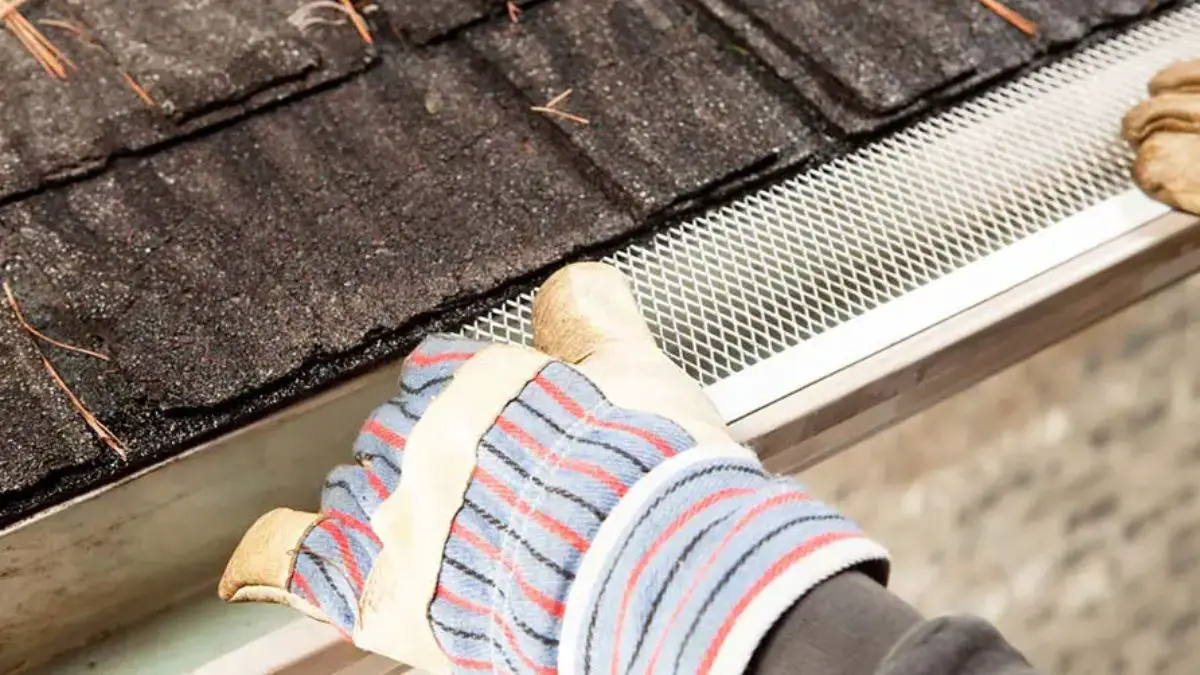
Gutters are a beneficial addition to homes. And it serves more than one purpose. The first and most obvious one is water collection. Then there is to ease corrosion. And lastly, direct water out of your property to avoid flooding.
But can gutters drain into the sewer?
The contractors installing the gutters can connect the gutter outlet to a sewer line. However, most states consider this connection illegal. And if the law catches up with you doing this, you may pay a hefty fine. And so, to mitigate such issues, it is best to confirm with the authorities in your state before misfortune befalls you.
Most homeowners are skeptical at first. But they should realize that installing them has pros and cons.
Gutters can help protect your property from water damage by reducing storm runoff onto your property’s foundation and windowsills. They also allow rainwater to seep slowly into the ground, preventing erosion in environmentally sensitive areas. These are places such as wetlands or coastal zones prone to flooding during heavy rains.
If not maintained adequately, gutters can cause water overflows. With blockages, they become a headache. And gutter installation can be costly.
But what about gutter drainage? Do you know what it is? Or how it works?
If not, keep reading as I share my research with you.
Recommended Reading: Are Gutter Guards Worth It or a Waste of Money? We Ask the Pros
What Is Gutter Drainage And How Does It Work?
Gutter drainage is a process that prevents water from staying in your gutters. It further prevents water from seeping into the walls of your home.
Gutters and downspouts are essential for maintaining the health of your roof, foundation, and landscaping. Gutters channel water away from the house to help prevent erosion on a property.
Water will naturally flow down. But if it can’t leave due to clogged gutters, it will eventually work its way back up the roof and into the interior of your house. Some common clogging causes are leaves, dirt, sticks, or other debris. If you want to keep water out of your home and avoid costly repairs later on, you must watch the gutters!
Ensure they stay as clean as possible with minimal effort by doing the following things. First, keep them clean by blowing off any debris before they settle in too deeply. The second is to maintain them by fixing holes and loose connections.
Why Shouldn’t You Hook Up Your Downspouts To The Sewer System?
This connection is illegal, but why?
In Case Of Heavy Rains, It Can Cause An Overflow
The sewer system can experience an overflow when you connect the gutter system. The water that falls on the roofs is a lot of gallons when it rains heavily. And so the sewer tanks can only accommodate enough, and adding this rainwater will overwhelm it.
This overflow, in most cases, is not pretty. All the fecal matter mixed with urine and water will come back up and flow on the surface, which is not sanitary or safe.
It Can Cause Blockages To The Sewer System
This is another reason you should not connect your downspouts to the sanitary sewer—waste materials, including dust, debris, twigs, and leaves, may be settling on the roof. So, when the rain pours, all these items finally end up in the sewer system. The result is frequent clogging by the garbage.
The Main Problems
You may not consider it a problem initially, but it will cost you and the city later.
Removing these items from the sewer system is messy and very costly. Not to mention the health hazard this unsanitary water poses. Since this water makes it to the surface, people can get into contact and get waterborne diseases. This same contaminated water may get into drinking water reservoirs, spreading pathogens that cause diseases.
On a broader picture, this water may also reach water wildlife, killing and causing havoc. This further endangers the world’s ecosystem. Soil pollution is another possibility when sewer water breaks free from the pipes. The immense pressure may also cause sewer pipes to burst, yet another danger and expense.
Sure, one might argue that the state’s wastewater treatment facilities will clean this water, and they are right. The only issue is that the facility must use more resources to clean. They will use more purifiers to match the water volume, which adds to the overall cost.
Where Do Gutters Drain To?
Gutters are best drained to tank reservoirs, which can best benefit you during a water shortage.
There are general rules on where you should install your downspouts to drain. Here they are:
- You should place at least 40 linear feet of space from one gutter to the next. This ensures that the gutters provide adequate drainage during a heavy downpour. When you place them too close to each other, they may cause water to settle, thus seeping into the ground.
- It would help if you positioned every gutter outlet in a slopping place. This is to avoid water pooling around the house. The slope allows the water to drain away further from the home and not towards it.
- You can also drain this water in tank reservoirs that you have in your home. This is best in areas that experience water shortages. Regardless, it is a good practice as you collect all that water for house chores. You can also use purified rainwater for drinking.
Usage For Gutters To Water Flower Beds
Gutters can be instrumental in helping you keep your garden lush and flourishing. However, the amount of water that makes it here must be sufficient and not too much. When there’s too much water, it oversaturates the soil and induces the rotting of the plant’s roots. This is results in the plants dying off.
But here is a better way to do it:
You can store and use this water to hydrate your plants and flower beds without rain. You may use a piping system or pour water using a bucket.
What Is Drainage?
Drainage is the process of removing water and other fluids from an area. There are many reasons for drainage, such as preventing flooding or removing water accumulating on a surface. In some cases, you can use it to maintain healthy living conditions.
There are several different types of drainage systems, including but not limited to:
- Gutters that direct rainwater
- Drywells- a type of passive system
- Underground pipes that carry away wastewater
- Sump pumps that you use to pump out standing water.
- Storm drains assist by directing rainwater into larger pipes that lead toward rivers or streams.
The choice between these methods will depend on location and property size.
Pros Of Drainage
Drainage is an essential factor in home construction that can determine the quality of your living space. Homeowners are often unaware of drainage, but it’s a crucial part of any property.
Here are some of the pros of a drainage system:
It Prevents Water Accumulation
When water accumulates in an undesignated area, it brews several disasters. The first is that it oversaturates the soil, killing plants by rotting.
Secondly, it becomes a breeding ground for insects that spread diseases.
It Reduces Soil Erosion
Soil erosion is when water sweeps away the top layer of the soil, displacing it elsewhere. With proper drainage, water only flows where it has been led to flow, helping maintain the soil layers as they should be.
It Can Help You Collect Water For Later Use
Yet another benefit of a good drainage system is the chance to collect water in tanks, mostly underground tanks. And then, you can utilize this water to irrigate your flower bed, wash the car, or even the driveway.
It Helps Keep the Infrastructure Intact
Water is the number one cause of road deterioration and homes’ foundations becoming weak. And so when an area has a drainage system, all this excess water drains away, leaving the roads and buildings intact.
Cons of Drainage
On the other side of the coin, here are the cons of a drainage system:
Expensive To Install
The number one con is that installing a drainage system is very expensive. The initial investment is always on the higher end. The main cost factors are the materials, process, and labor used during these projects.
Maintenance Is Labor-Intensive And Expensive
After contractors fully complete the construction of a drainage system, the work on maintenance starts. And maintenance never stops; it is continuous.
It entails the unclogging of the pipes and the removal of silt and other debris. And these activities are not cheap; they cost quite a lot. Repairs and replacements also add to the bill.
Types Of Residential Drainage Systems
Water is life but it can also be destructive if left to run wild. And that is why waterproofing your home is essential. So how do you achieve this?
Simple, by installing the proper drainage systems within your property. The following are the types you need to know.
Surface Drainage System
This is a pattern of open ditches that you dig parallel to the ground. They are shallow and take the role of running off excess water from your driveway or garden.
They lead to a larger pipe away from your home and help mitigate flooding and water pooling. You can install these around your home, the driveway, and the walkway.
Subsurface Drainage System
This is what engineers call the French drain. You ideally install it beneath the top layers of the soil. They serve the purpose of removing excess water from the soil. It is instrumental in vegetative areas as it helps prevent the plants’ roots from rotting.
The installation requires digging deep trenches and expert intervention to work efficiently.
Slope Drainage System
These pipes help water flow away from the property using the force of gravity.
Materials for making slope drainages are usually hard plastic, concrete, or steel covered with a durable grating material.
Gutters And Downspout Systems
These are the installments that are attached to the houses and buildings. The gutters collect water from the roof, and the downspout leads it to the ground.
Gutters can be open or semi-closed, while downspouts are round or rectangular. Both can be aluminum or steel, as per your preference.
The downspout can lead the water into the surface of the slope drain to avoid water pooling.
How To Install A Drain System Into Your Property
When installing a drain system on your property, you must consider the whole water cycle. The method you install must accommodate the natural water flow from when it hits your roof until it leaves your property.
So here is how you do the installation on your property, starting with the gutters:
Gutter Installation
The first thing to consider is the material gutters you will use. You have the choice of either aluminum or steel. Steel is more robust and heavier, meaning it will sustain its appearance and shape.
Even when hit by twigs or water freezes to become ice, a steel gutter will remain intact in its original shape. On the other hand, aluminum is light and prone to damage on hard impact.
So the ideal one you should use is steel. But if you install it yourself, aluminum is the best to go with, as you can handle its weight.
The next step is gathering all the components and knowing where they fit. After that, you install them, ensuring that you securely lock them into place. There is so much nitty-gritty during installation, which is why getting a pro is the best solution.
Downspout Installation
The downspouts are the pipes carrying water from the gutter and extending it to the ground. Their installation also has a few factors to consider, like the length of the downspout.
Since they use gravity to move the water, the most crucial part of the installation is the outlet. Ideally, it would help if you placed the lower mouth a few feet from the house wall. This is to avoid flooding and water seeping into the walls and destroying the foundation.
Remember: Do not connect this system to the sewer line if the law prohibits it.
Underground Pipes
Contractors also build underground pipes during home construction, leading all the property’s wastewater to the sewer line. This means the water from the washrooms, sinks, and drains.
These pipes need the highest quality as you do not want to switch them later. One more thing is to ensure that you bury them deep into the soil to avoid damage.
Sump Pumps
Since you use sump pumps to drain stagnant water, the ideal place to install it is where water naturally settles. Dig a hole for the sump pump and insulate it using gravel and PVC. Then connect it to all the adapters, check the valve, and ensure it is airtight.
There is so much that goes into installing a sump pump. However, if you do your homework, you can achieve it as a DIY project. Nevertheless, it is best to go with a professional.
Storm Drains
Installing storm drains is a big job and perhaps something you should leave for the county or state. They include huge pipes as large as 4 feet in diameter.
It is a job that requires trained and experienced personnel. Like the French drains, other drains may also require an appropriate labor force.
Bottom Line
It’s not good to connect your gutter drain to the sewer line. This will cause the system to overflow, which is dangerous for public health and safety. Even so, specific laws may prohibit it depending on where you live.
If this sounds like something you want to do anyway (despite all advice against doing so), get some help from professional plumbing experts before making any moves. You don’t want things getting out of control!







